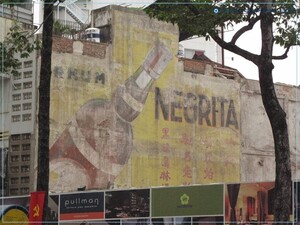-
 1 of 3
1 of 3![2 of 3 2 of 3]() 2 of 3
2 of 3![3 of 3 3 of 3]() 3 of 3
3 of 3-
sample chapter: Negrita
A Taste of Old Saigon
More than half a century ago, some time in the 1950s, a small triangle of vacant land lay at the confluence of Tran Hung Dao and Nguyen Cu Trinh Streets. Its address today is 148 Tran Hung Dao, on the way west to Cho Lon (the Chinese district). Some time back in those olden days, I don’t know exactly when, it might even have been in the waning days of French rule, a billboard size advertisement was painted on the eastern wall of the adjacent building. The ad was for Negrita Rum, a very popular tipple here from earliest French days to Reunification in 1975 when it pretty much disappeared. But until that time it was the drink of choice for many Foreign Legion soldiers, their heirs the American G.I.s, and who knows how many hard drinking journalists. The ad features Chinese script, which is appropriate to one’s destination should you see it driving westward down the street.
Negrita Rum (the French spell it “rhum”) was first blended and labeled in 1847 by the Bardinet Company of France. And Bardinet still produces it. It’s the most popular rum in Spain and high on the list in other European countries. It’s a blended rum, being made in distilleries on Reunion, Guadeloupe and Martinique islands. It’s the Martinique element that gives Negrita its distinctive taste. Rums of Martinique are “"rum agricole." They are made from sugar cane juice, not molasses, a by-product of the refining process. The painted ad on Tran Hung Dao (in the French time known as Rue Marine, or Sailor Street) would have beckoned thousands of soldiers and sailors as they headed into Cho Lon for nights of debauchery at the House of 500 girls. It would have stimulated the thirst of gamblers flocking to Le Grande Monde. The dark lady on the label might have winked at Graham Green as he scoured the steamy streets in search of atmo to spice up The Quiet American. She was part of a neighborhood and a city whose former character is now almost entirely gone. But she has been (temporarily) preserved. In 1960 the Metropole hotel was built on that triangle of land, hard against the adjacent building, sealing up the commercial art as a time capsule. Through all the subsequent decades of war, upheaval, high times and low, change, change and hyper change, the painted Negrita slept.
She had not been seen for 50 years, until last December. With yet another tower in mind, developers demolished the venerable Metropole in that month, revealing that shrouded bit of bibulous history. I stopped in my tracks when I saw her. I must have stood and contemplated her for ten minutes, imagining all the people and events that she had witnessed, and those she had slept through. I resolved to have a drink of Negrita. I had to have a sip of Saigon history. But where to find something that disappeared decades ago?
I called my bibulous buddies. Michael Kloster, formerly of Black Cat fame and now with The Vine Group wine merchants; Linh Phanroy of Gringo’s Bar; and Charlie Wong the Hot Dog King of Saigon all went to work and did their best. But the search seemed to be in vain. Kloster managed to locate a bottle in Phnom Penh and was standing by to have it “transferred.” Phanroy promised to invent a dedicatory cocktail for it upon arrival. But King Charlie’s network of informants and operatives proved unmatched. As we sat despondently one night nursing our suds at the Drunken Duck, a dusty and battered old xe om (motorbike taxi) arrived at the door. Both driver and vehicle looked hard-ridden. A barman was dispatched to meet him. A fat wad of cash changed hands. A bottle of Negrita rum was set before me. It was a thing of beauty.
We four repaired to my quarters. With due ceremony I cracked the bottle. I poured four measures. We toasted Old Saigon. We tasted. How was it? Well may you ask. “She weren’t a goer,” as an Aussie might say. But she weren’t bad neither. I didn’t care. I tasted Old Saigon, and that was more than enough for me. Phanroy made good on his promise. He combined equal measures of café sua da, Kalua and Negrita. He calls it the Negringa. I plan to make that bottle last until the Negrita ad is once more consigned to darkness, no doubt for good this time. I pass by that echo of Old Saigon every day on my way home. And every day in my mind I drink a silent toast to her. And she replies, “I just came back to say goodbye.”

